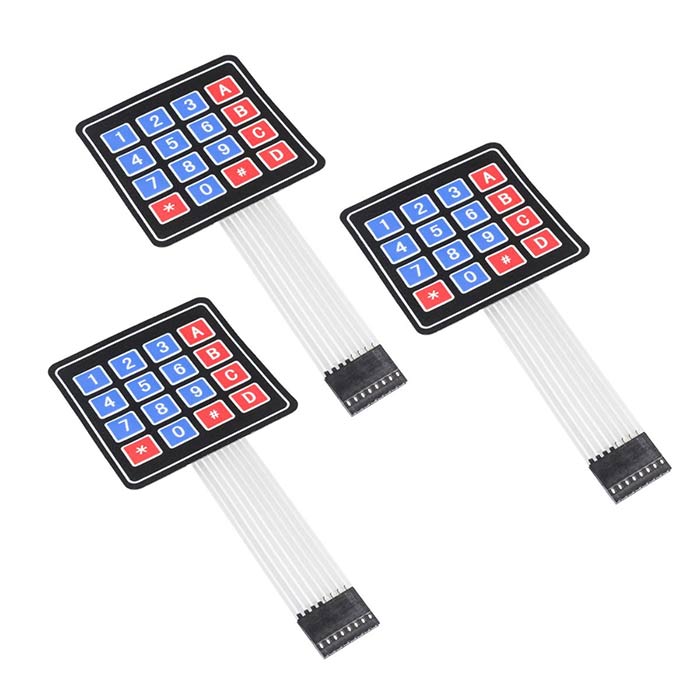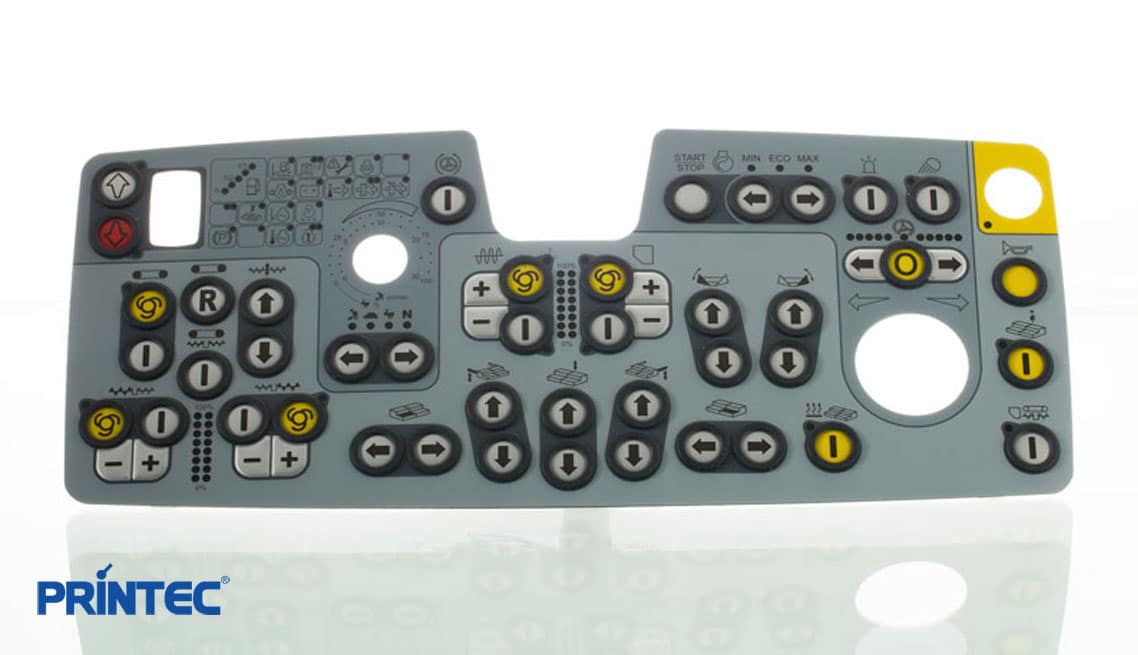Locating a reliable membrane switch manufacturer is important for top-quality electronic interfaces.
Everything About Membrane Layer Change: Comprehending Its Style and Capability
When you assume concerning the control user interfaces in modern-day tools, membrane layer buttons usually come to mind. Allow's discover what collections membrane layer changes apart from various other control systems.
What Are Membrane Layer Buttons?

Their smooth nature makes them very easy to tidy and resistant to dirt and dampness, a vital attribute in lots of atmospheres. Membrane layer buttons can likewise be customized relating to shape, size, and graphics, permitting suppliers to produce distinct user interfaces tailored to specific products. Plus, they're lightweight and slim, which aids in lessening the general mass of tools. In general, membrane layer switches play a significant function in enhancing customer experience across a wide array of applications.
Just How Membrane Changes Job
When you press a secret on a membrane button, it turns on a straightforward yet efficient system. The leading layer, typically made of versatile product, pushes down onto a conductive layer below it. This action bridges the void in between conductive traces, completing an electric circuit. As quickly as the circuit shuts, it sends a signal to the tool's controller, which interprets your input.
You'll discover that the responsive responses varies based upon the button design, providing either a soft click or a much more noticable action. Once you release the secret, the membrane layer go back to its original position, reopening the circuit and quiting the signal. This procedure takes place almost instantly, making sure a responsive user experience.
Membrane buttons are preferred due to their toughness and resistance to dust and dampness, making them excellent for numerous applications, from family devices to clinical devices. Recognizing this procedure assists you appreciate their prevalent use.
Trick Parts of Membrane Layer Switches
Understanding the crucial components of membrane buttons is fundamental for realizing their functionality and design. The protective layer guards versus ecological aspects and use, extending the switch's life expectancy. By understanding these parts, you'll acquire understanding right into just how membrane layer switches operate and their value in numerous applications.
Products Utilized in Membrane Change Style
The performance and sturdiness of membrane layer switches greatly depend upon the products made use of in their style. You normally experience polyester and polycarbonate as key substrates because of their superb toughness and flexibility. These materials withstand scratches and chemicals, making them suitable for demanding environments.
The conductive layers commonly utilize silver or carbon, chosen for their reliability and conductivity. membrane switch manufacturer. Silver supplies remarkable performance, while carbon is an economical alternative. For the overlay, you may take into consideration a matte or shiny finish, depending on your visual requirements and individual experience
Make certain to choose adhesives that withstand environmental elements like temperature and humidity. Selecting the ideal materials will assure your membrane button stands the test of time.
Layout Factors To Consider for Membrane Switches
While creating membrane switches, it's crucial to take into consideration various variables that affect their capability and user experience. Beginning by concentrating on the format and switch size; make sure they're instinctive and very easy to navigate. Take into consideration the tactile feedback you want to you can check here provide-- will users need a visible click or a softer touch? Additionally, assume regarding the materials you'll make use of, as they'll affect resilience and looks.
Verify your style accommodates ecological elements, like dampness or temperature level variations, which might impact efficiency. By thoroughly thinking about these elements, you'll create a membrane layer button that improves usability and fulfillment.
Applications of Membrane Switches
Membrane layer switches imp source are versatile components located in numerous applications, from commercial devices to customer electronic devices. You'll see their impact in makers that require sturdy user interfaces and in tools that gain from smooth styles. Understanding these applications helps you appreciate the performance and functionality of membrane switches in everyday modern technology.
Industrial Tools Use
When you're looking to boost the functionality of commercial equipment, membrane layer buttons supply a trustworthy option that incorporates resilience with straightforward style. These buttons are excellent for severe settings, giving resistance to dust, moisture, and chemicals. Welcome membrane buttons to enhance your procedures and enhance overall efficiency.
Customer Electronic Devices Assimilation
In the domain of customer electronic devices, membrane layer switches play a vital duty in boosting customer communication and tool performance. You'll locate them in devices like microwaves, push-button controls, and video gaming consoles, supplying a seamless method to interact with technology. Their streamlined design enables for easy assimilation into different products, making controls intuitive and user-friendly. With their capability to include graphics and backlighting, you can appreciate a modern-day visual that matches the gadget's total look. Membrane buttons additionally ensure toughness and resistance to dust and dampness, extending the life expectancy of your electronic devices. By picking membrane switches, you enhance not simply the functionality yet additionally the design of your tools, making daily interactions smooth and delightful.
Benefits and Disadvantages of Membrane Layer Buttons
While membrane switches offer a series of advantages, they likewise feature some disadvantages that you must consider. One substantial benefit is their compact design, making them perfect for space-constrained applications. They're also affordable, offering a long lasting service with a low production price. official statement In enhancement, their seamless surface is very easy to clean, improving health in settings like healthcare facilities.

Nevertheless, there are downsides. Membrane switches can have a much shorter lifespan contrasted to mechanical buttons, especially under heavy usage. They can additionally be much less responsive, which could influence customer feedback throughout operation. If damaged, repairing them can be tough and frequently requires full substitute. Eventually, their sensitivity to severe temperatures and environmental conditions may restrict their efficiency in particular settings. Balancing these advantages and disadvantages will certainly aid you establish if membrane layer buttons are the appropriate fit for your job.
Often Asked Questions
For How Long Do Membrane Layer Switches Over Typically Last?
Membrane switches over usually last between 5 to 10 years, relying on usage and environmental problems. You'll wish to review factors like wear, exposure to dampness, and temperature variations to evaluate their durability successfully.
Can Membrane Switches Be Customized for Specific Designs?
Yes, you can customize membrane layer switches to fit details layouts (membrane switch manufacturer). You'll have the freedom to pick shades, forms, and formats that match your job's demands, guaranteeing they mix seamlessly with your general visual
What Is the Price Variety for Membrane Switch Manufacturing?
The price range for membrane switch manufacturing typically drops in between $1 and $10 per unit, relying on elements like style intricacy, amount, and products. You can get quotes from suppliers to locate the best choice.

Are Membrane Layer Switches Over Water Resistant or Immune?
Membrane layer buttons can be created to be waterproof or resistant, depending upon products used and construction approaches. If you need them for wet atmospheres, assure you define those needs throughout the style procedure.
Just How Do Membrane Switches Over Contrast to Standard Switches?
Membrane buttons are generally thinner and more flexible than typical switches, providing a sleek style. They're often less complicated to clean and incorporate, but might not provide the tactile responses you're used to with mechanical alternatives.
Final thought
